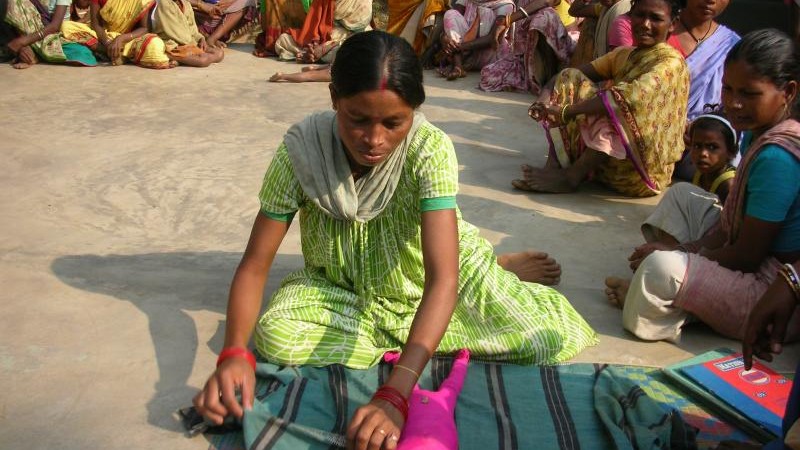
According to the UN Millennium Development Goals, India should bring down its maternal mortality rate (MMR) to 109 per 100,000 live births by 2015. This is a tough ask, as from an MMR of 437 per 100,000 live births in 1990-91 India has only achieved a reduction to 190 by 2013-2014.
Experts therefore believe that India is likely to miss its Millennium Development Goals target for MMR.
Safe birthing depends on how informed pregnant mothers are and whether the delivery is carried out by trained personnel and in institutional health facilities.
In many regions of India, a lack of health infrastructure to support institutional deliveries and pre- and post-natal care as well as a lack of awareness regarding existing schemes promoting institutional deliveries serve as major impediments to achieving the goal. Other factors such as early marriage of girls, poor nutrition among women and gender inequality increase maternal risk.
A report drafted by CommonHealth and Jan Swasthya Abhiyan, a coalition for maternal-neonatal healthcare and safe abortion, says that the public health system has failed women belonging to the Scheduled Castes, Scheduled Tribes and minority religious groups living in geographically remote areas, as well as migrants. The report shows that although the government runs several programmes, there is a great gap in accountability and governance and most of the programmes have been implemented poorly on the ground.
Citizen journalists from Video Volunteers — an international media and human rights NGO — have highlighted maternal healthcare problems at grassroots level in a series of videos.
Their stories reveal that while the government is encouraging women to deliver at institutions rather than at home, the public health system is crippled by shortages of health infrastructure, doctors, frontline health workers and medicine.
Corruption plays its part
In 2014, 56,000 women died during childbirth in India. The Indian government’s schemes Janani Suraksha Yojana and Janani Shishu Suraksha Karyakram make provisions to reduce out-of-pocket expenditure for women living below the poverty line, providing free antenatal check ups, IFA tablets, medicines, nutrition in health institutions, provisions for blood transfusion, and transport to and from health centres.
[video type='youtube' id='g9vRWJTRUXU' height='350']
However, according to the above video, which comprises footage taken by the hidden camera of citizen journalist Mary Nisha from the Godda district of Jharkhand:
The 24-year-old woman in labour was kept waiting for the doctor for six hours. The doctor on duty did not turn up and she delivered in the presence of a nurse. She was forced to pay INR 400 for her delivery and even to use the toilet. She received neither free medicine nor nutrition.
Lack of functional institutions
This video follows three women in Khatti village, Gariaband district, Chhattisgarh. One lost her baby six days after it was born due to a lack of medical assistance. Another had a stillborn baby resulting from an unassisted home birth while a third, who is nine months pregnant, has no access to healthcare.
[video type='youtube' id='USbTE5YFEMM' height='350']
This video by Reena Ramteke from Khatti village in Garyaband District of the state of Chattisgarh shows that the state-run health facility in the locality is constantly shut.
Laleshwari, 21, says no health worker has ever contacted her. Purnima, 20, had a stillbirth despite the fact the health centre was close to her home. She says the sub-health centre is open twice a month and the nurse at the facility is not present most of the time it is open. What options did she have?
Not a single delivery has taken place in the past decade in the sub-health centre in Khatti village. Indrani, 22, lost her child within six days of the birth due to an infection following a home delivery. During the delivery she called the duty nurse of the sub-health centre but was told by the nurse that she was at a meeting.
Bharti Kumari reports from Telmocho village, Dhanbad district, Jharkhand, that the main medical facility is unusable for health workers and patients, lacking functioning toilets and featuring a roof that leaks during the monsoon.
[video type='youtube' id='v4b5-bfUK-8' height='350']
The doctors of this facility also visit rarely. Thus, patients that can afford to have to visit a relatively costly private centre for childbirth.
Lack of manpower
Halima Ezaz from Dhanbad, Jharkhand, reports that one Auxiliary Nurse Midwife (ANM) from Jharkhand looks after 14 sub-health centres. Ahilya Devi, a septuagenarian, has responsibility for looking after pregnant women and women with new born babies, giving them nutrients, vaccinations, performing deliveries and so on. But she is not supplied with proper tools to work in a region where the power supply is unstable:
[video type='youtube' id='ZKRIPug6008' height='350']
Ahilya says:
We used to have rechargeable emergency lights, but those are broken. [If the lights go at night], we have to use candles and torches. How can we make stitches in this light?
Each of these videos highlights the obstacles to reducing the maternal mortality rate in India. Despite the government campaigns in place, India is lagging behind neighbours Bangladesh and Nepal in the fight against maternal mortality. There is also a huge disparity in terms of progress between different states in the vast country. Some states like Tamil Nadu, Delhi, Kerala and Andhra Pradesh have achieved their millennium development goals. But there are many — especially those with Scheduled Castes and Scheduled Tribes as well as minority religious groups — who are left trailing.
Watch this YouTube playlist on maternal health in India to learn more.
This article by Rezwan originally appeared on June 21,2015 on Global Voices.